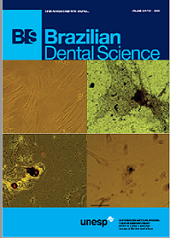Preventive and therapeutic effects of relaxin on bisphosphonaterelated osteonecrosis of the jaw: an experimental study in rats
DOI:
https://doi.org/10.14295/bds.2020.v23i1.1846Abstract
Objective: Bisphosphonate-related osteonecrosis of the jaw (BRONJ) is a challenging complication of chronic bisphosphonate (BP) use. The hormone relaxin is able to induce the multistep differentiation process of human osteoclastogenesis, exhibits anti-fibrotic and anti-inflammatory actions, and promotes vasodilatation, wound healing, and angiogenesis. The present study aimed to evaluate the effects of relaxin in the prevention and management of BRONJ. Material and Methods: Thirty-six male Sprague Dawley rats were randomly divided into four groups. Rats in group 1 (n = 10) received relaxin and BP simultaneously for 12 weeks. Rats in group 2 (n = 10) received injections of BP for 12 weeks, followed by relaxin for another 12 weeks. Rats in group 3 (n = 10) received only BP injections, and those in group 4 (control, n = 6) received only saline. Necrosis and inflammation in the rats’ mandibles were evaluated as indicators of BRONJ. Results: Necrosis and inflammation were not detected in group 1 (BP + relaxin). In group 3 (BP only), incidence rates of necrosis and inflammation were 90% and 60%, respectively. Conclusions: Our findings suggest that relaxin may be potently effective in preventing BRONJ and have some benefit in the treatment of existing BRONJ.
KEYWORDS
Animal model; BRONJ; Relaxin.
Downloads
Downloads
Published
How to Cite
Issue
Section
License
Brazilian Dental Science uses the Creative Commons (CC-BY 4.0) license, thus preserving the integrity of articles in an open access environment. The journal allows the author to retain publishing rights without restrictions.
=================




























